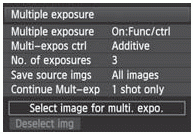Merging multiple exposures with an image recorded in the card
- You can select an image recorded in the card as the first single exposure. The original of the selected image will remain intact. You can only select
 You cannot select
You cannot select 
 or JPEG images
or JPEG images
 | 1 Select [Select image for multi. expo.]. 2 Select an image. Turn the < > dial to select the image to be used as the first single exposure, then press < > dial to select the image to be used as the first single exposure, then press < >. >. Turn the < > dial to select [OK]. > dial to select [OK].
3 Take the picture. - When you select the first image, the number of remaining exposures as set with [No. of exposures] will decrease by 1. For example, if [of exposures] is 3, you can shoot two exposures.
|
Images shot with highlight tone priority set to [Enable], images of which the aspect ratio is other than 3:2, or those with cropping information appended cannot be selected as the first single exposure.
Auto Lighting Optimizer, peripheral illumination correction and chromatic aberration correction will be disabled, regardless of the settings of the  image selected as the first single exposure.
image selected as the first single exposure.
The ISO speed, Picture Style, high ISO speed noise reduction, and color space, etc. set for the first  image will also be set for the subsequent images.
image will also be set for the subsequent images.
If the first  image’s Picture Style is [Auto], the [Standard] Picture Style will be set for the subsequent images.
image’s Picture Style is [Auto], the [Standard] Picture Style will be set for the subsequent images.
- You cannot select an image taken with another camera.